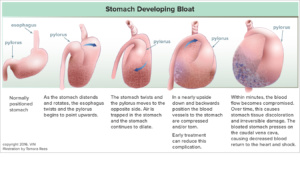Most people are not familiar with the term Gastric Dilatation Volvulus, or GDV, but most dog owners have heard of the term bloat or stomach torsion. For those who are not familiar, or those who need a refresher, GDV is the result of the stomach becoming full of air and then twisting upon itself. Although one of the possibilities is exercise shortly after drinking or eating, the exact factors leading to this condition are not known. This illustration from VIN.com demonstrates the sequence of events leading to a GDV.

www.VeterinaryPartner.com – Keyword Bloat

Great Danes are the #1 breed at risk for GDV.
Deep chested breeds are at higher risk of developing torsion, with Great Danes leading the pack. Although this condition can develop in any large breed dog, we see it more frequently in Danes, Shepherds, Boxers, St. Bernards, and Dobermans. According to VIN.com dogs over 99 lbs of body weight have a 20% risk of torsion. This is an important topic for me since one of dogs, Bowie the Dane-Ridgeback-Boxer mix, was my very first surgery patient with a GDV approximately 14 years ago. Thankfully we caught it early and he had a full recovery with no recurrences.
Signs of GDV occur rapidly after torsion and include: bloated abdomen (usually one sided distention), drooling, lethargy, dry heaving and unproductive attempts at vomiting. This is an emergency and literally every minute counts. Once torsion occurs, the stomach’s blood supply is compromised which causes the stomach to die off within hours. Another problem is that the twist may also incorporate the spleen making things more serious. Treatment for GDV involves decompression of the air, surgery to return the stomach to its normal position, removal of the spleen if damaged, and tacking of the stomach wall to the body wall to prevent it from twisting again. Although not 100%, recurrence after tacking is as low as 6%. Without tacking, recurrence is as high as 76%. Studies have shown between 71.5% and 83.8% survival with surgery (vin.com).
Dogs that suffer from a GDV are at risk of cardiac arrhythmias and electrolyte imbalances. Most spend a few days in critical care being monitored to look for post-operative problems. Emergency treatment, surgery, and critical care can be very expensive. At our facility it ranges from $1,200 – 2,000 without complications. At some emergency hospitals the cost can be as high as $6,000. This is usually hard to come by in a short period of time, and these are emergencies with no time to wait.
So what can be done to prevent this condition? There are many factors believed to contribute to GDV, like feeding only one meal a day and dogs that eat too quickly. However, there is no good way to determine what will cause an individual dog to bloat. The best way to prevent a GDV is a procedure called a Prophylactic Gastropexy. This is a procedure usually performed at the time of spay/neuter and it tacks the stomach to the body wall to prevent in from twisting. A dog may still get bloated which is uncomfortable, but this procedure helps decrease the risk of bloating significantly.
A Prophylactic Gastropexy at our facility is around $400-500 when done with a spay/neuter procedure and most clinics offer it for under $1,000. In addition to saving money on the cost of an emergency surgery to correct a GDV, you could also be saving your dog’s life since, even if you have the money to do surgery, if it is not caught in time there may be nothing that can be done to save your dog. We always recommend it for Great Danes, as studies show as high as 37% risk of developing a GDV (Ward et al, 2003). Another thing to keep in mind is that, even though it is usually done at the time of spay/neuter, a Prophylactic Gastropexy can be performed at any time. Some veterinarians are also able to perform the procedure laparoscopically (minimally invasive surgery). All surgeries have risks, so you should discuss with your veterinarian the pros and cons of having this done and the risk to your pet based on breed.
If you would like to submit a topic or specific question you would like for Dr. G to address in this blog, let us know by sending an email with Rascal’s Corner in the subject line.
Email to askDrG@generationwags.com
To view all posts in Rascal’s Corner click here!

